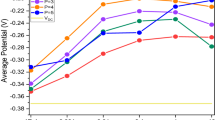Abstract
Effect of pulse reverse current on the microstructure of a copper electro-deposition was studied to make copper-mesh on a transparent polyimide (PI) film for electromagnetic interference materials. Thiourea as an organic additive in a modified copper sulfate bath significantly influenced micro-structure of the deposits. Smooth surface and preferred orientation were observed in the layers with the organic additive. Square wave pulse was more useful to produce a micro-sized copper-mesh.
Similar content being viewed by others
References
A. Turonova, M. Galova, and M. Supicova, “Parameters influencing the eletrodeposition of a Ni-Cu coating on Fe powders. I. Effect of the electrolyte composition and current density,” Solid State Electrochem. 7, 684–688 (2003).
V. Tutovan and N. Velican, “Magnetic properties of electrodeposited Ni-Co thin films,” Thin Solid Films 7, 219–227 (1971).
M. Kim, J. Y. Lee, S. C. Kwon, D. S. Kim, I. G. Kim, and Y. Choi, “Application of small angle neutron scattering to analyze precision nickel mesh for electromagnetic interference shielding formed by continuous electroforming technique,” Physica B: Condens. Matter 385, 914–916 (2006).
T. Y. B. Leung, M. Kang, B. F. Corry, and A. A. Gewirth, “Benzotriazole as an additive for copper electrodeposition influence of triazole ring substitution,” J. Electrochem. Soc. 147, 3326–3337 (2000).
L. Mizushima, M. Chikazawa, and T. Watanabe, “Microstructure of electrodeposited Cu-Ni binary alloy films,” J. Electrochem. Soc. 147, 1978–1983 (1996).
Y. Choi, M. Kim, and S. C. Kwon, “Characterization of chrome layer formed by pulse plating,” Surf. Coat. Technol. 169, 81–84 (2003).
E. Chasseing, K. V. Quang, and R. Wiart, “Mechanism of copper-nickel alloy electrodeposition,” J. Appl. Electrochem. 17, 1267–1280 (1987).
P. Cofre and A. Bustos, “Voltammetric behavior of the copper(II)-thiourea system in sulphuric acid medium at platinum and glassy carbon electrodes,” J. Appl. Electrochem. 24, 564–568(1994).
N. V. Mandich, “Chemistry and theory of chromium deposition: Part I. Chemistry,” Plat. Surf. Finish. 84, 108–115 (1997).
N. Tantavichet and M. D. Pritzker, “Effect of plating mode, thiourea and chloride on the morphology of copper deposits produced in acidic sulphate solutions,” Electrochem. Acta 50, 1849–1861 (2005).
Author information
Authors and Affiliations
Corresponding author
Additional information
The article is published in the original.
Rights and permissions
About this article
Cite this article
Song, C.H., Kim, M., Lee, JY. et al. Effect of pulse reverse current on the micro-structure development of thin copper mesh on transparent polyimide film. Phys. Metals Metallogr. 115, 1375–1378 (2014). https://doi.org/10.1134/S0031918X14130110
Received:
Accepted:
Published:
Issue Date:
DOI: https://doi.org/10.1134/S0031918X14130110



